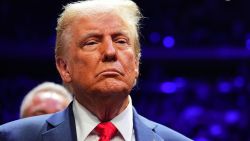President-elect Donald Trump on Monday promised massive hikes in tariffs on goods coming from Mexico, Canada and China starting on the first day of his administration, a policy that could sharply increase costs for American businesses and consumers.
The move, Trump said, will be in retaliation for illegal immigration and “crime and drugs” coming across the border.
“On January 20th, as one of my many first Executive Orders, I will sign all necessary documents to charge Mexico and Canada a 25% Tariff on ALL products coming into the United States, and its ridiculous Open Borders,” Trump posted on his Truth Social platform. “This Tariff will remain in effect until such time as Drugs, in particular Fentanyl, and all Illegal Aliens stop this Invasion of our Country!”
Trump said America’s neighbors can “easily solve this long simmering problem.”
Similarly, Trump said that China will face higher tariffs on its goods – by 10% above any existing tariffs – until it prevents the flow of illegal drugs into the United States.
“I have had many talks with China about the massive amounts of drugs, in particular Fentanyl, being sent into the United States – But to no avail,” Trump posted on Truth Social.
The president-elect claimed in the post that Chinese officials promised him the country would execute drug dealers caught funneling drugs into the United States but “never followed through.”
Responding to Trump’s announcement, Chinese Embassy spokesperson Liu Pengyu said his country has been in communication with the US about counternarcotics operations and that “the idea of China knowingly allowing fentanyl precursors to flow into the United States runs completely counter to facts and reality.”
“About the issue of US tariffs on China, China believes that China-Us economic and trade cooperation is mutually beneficial in nature. No one will win a trade war or a tariff war,” Liu said in a statement to CNN.
Mexico’s President Claudia Sheinbaum responded Tuesday, warning the president-elect that “neither threats nor tariffs will solve the issue of migration or drug consumption.”
“Imposing one tariff would mean another comes in response, continuing like this until we put shared companies at risk,” she said, reading from a letter addressed to Trump.
Canadian officials responded to the announcement in a statement posted to X on Monday night, saying that their country “places the highest priority on border security and the integrity of our shared border” and is “essential to US domestic energy supply.”
“We will of course continue to discuss these issues with the incoming administration,” Canada’s Deputy Prime Minister Chrystia Freeland and Public Safety Minister Dominic LeBlanc said in the statement.
Canadian Prime Minister Justin Trudeau called Trump shortly after his social media post, an official with the prime minister’s office said. The brief call was focused on border security and trade, a senior Canadian government source told CNN. They characterized the call as productive and said that Trudeau and Trump promised to stay in touch in the days to come.
Trudeau confirmed the call in Ottawa before arriving at a Cabinet meeting, saying, “This is a relationship that we know takes a certain amount of working on and that’s what we’ll do.”
“We obviously talked about laying out the facts, talking about how, how the intense and effective connections between our two countries flow back and forth,” Trudeau said. “We talked about some of the challenges that we can work on together and it was a good call. It’s something that we can do laying out the facts moving forward in constructive ways.”
A significant policy change
The punishing tariffs, if enacted, could wreak havoc on America’s supply chains and industries reliant on goods from the country’s closest trading partners.
“The measures proposed this evening could hit a number of strategic US industrial sectors hard, add approximately $272 billion a year to tax burdens, raise goods prices, lift interest rates, and sap strength in an already-vulnerable household sector,” said Karl Schamotta, chief market strategist at Corpay Cross-Border Solutions.
Immediately after the announcement, the Canadian dollar fell 1.2% against the US dollar, and the Mexican peso fell 2% against the dollar, but both recovered some of their losses Tuesday morning. China’s yuan, though controlled by the government, traded higher – above 7.6% – in offshore markets.
Although investors believed the tariffs could ultimately strengthen the dollar, America’s financial markets took a hit, too. The extraordinary tariffs would raise costs dramatically for Americans for everyday goods that had previously come over the border without any import taxes.
That stunning shift could stymie economic growth, especially if inflation-weary consumers spend less in the face of higher costs.
The Dow fell 50 points, or 0.1%, Tuesday. The broader S&P 500 and Nasdaq were slightly higher.
What America imports
The United States’ top import from Canada is oil, which reached a record 4.3 million barrels per day in July, according to the US Energy Information Administration. America also imports cars, machinery and other various commodities, plastics and wood from Canada, according to the United Nations’ Comtrade.
America imports the majority of its cars and car parts from Mexico, which surpassed China as the top exporter to the US in 2023, according to trade data released by the Commerce Department earlier this year. Mexico is also a major supplier of electronics, machinery, oil and optical apparatus, and a significant amount of furniture and alcohol comes from the country into the United States.
The United States imports a significant amount of electronics from China, in addition to machinery, toys, games, sports equipment, furniture and plastics.
During Trump’s first term, CNN reported that he implemented tariffs on about $380 billion worth of goods that applied to thousands of Chinese-made products, including baseball hats, luggage, bicycles, TVs and sneakers. The Trump tariffs also hit foreign steel, aluminum, washing machines and solar panels.
Many US imports from Canada and Mexico are exempted from tariffs because of the USMCA trade agreement between the three nations that Trump pushed for during his first administration. It’s not clear how Trump would plan to implement the proposed tariffs without violating the USMCA.
Trump has routinely referenced the passage of the USMCA, which replaced NAFTA, as a political victory and a highlight of his presidency.
Trump’s tariff plan
Trump campaigned on using tariffs as a cudgel against foreign countries – as he did in his first administration – to grow domestic manufacturing while increasing tax revenue to pay for large revenue gaps that his proposed tax cut plan would create.
Tariffs effectively serve as a tax on goods imported to the United States. Although Trump has repeatedly said targeted foreign countries pay the tariffs, they are in fact paid by companies that purchase the imported goods – and those costs are typically passed onto American consumers. Most mainstream economists believe tariffs will be inflationary, and the Peterson Institute for International Economics has estimated Trump’s proposed tariffs (before the new tariffs announced Monday night) would cost the typical US household over $2,600 a year.
Scott Bessent, Trump’s pick for Treasury secretary, has said that tariffs would not add to inflation if they are implemented correctly. Wall Street cheered Bessent’s appointment, because he is widely expected to roll out tariffs gradually.
Although Bessent, if confirmed by the Senate, will be partly responsible for implementing the tariffs, in coordination with the Commerce secretary and US Trade Representative, Trump as president would wield significant power to levy tariffs with the stroke of a pen. He did just that when he was last in the White House, placing large tariffs on goods, primarily from China.
The problem with tariffs is that they often result in retaliatory actions by targeted countries, kicking off a trade war – and that’s exactly what happened during Trump’s first term. That blunted the tariffs’ effect on domestic manufacturing, because manufacturers’ goods became less attractive to overseas buyers.
Trump has promised significantly larger tariffs during his second term. Although he continues to discuss many different numbers, he has proposed a tariff upward of 60% on all Chinese goods, as well as an across-the-board tariff of either 10% or 20% on all other imports into the US.
This story has been updated with additional context and developments.
CNN’s Matt Egan, Paula Newton, Jack Guy and Jack Forrest contributed to this report.




















